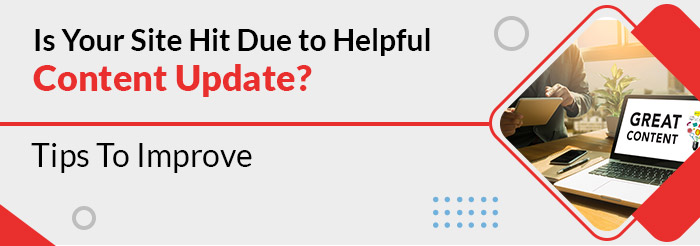Is Your Site Hit Due to Helpful Content Update? Tips To Improve
Posted on
In the ever-evolving world of digital marketing, staying ahead of the curve is crucial for success. Google, being the search engine giant, frequently updates its algorithms to enhance user experience and provide the most relevant information. One of the latest updates that has sent ripples through the digital marketing sphere is the “Helpful Content Update.” In this blog post, we will delve into what exactly this update entails, its significance in the realm of SEO, and how you can ensure your content aligns with Google’s latest standards.
What Exactly Is Google Helpful Content Update?
Google’s algorithms are designed to prioritize content that is genuinely helpful to users. The Helpful Content Update is an algorithmic tweak aimed at surfacing content that is not only relevant but also valuable to users. It goes beyond mere keyword matching and focuses on understanding the context and intent behind user queries. This update is part of Google’s ongoing efforts to refine search results and ensure users find information that truly addresses their needs.

What Is the Importance of Google the Helpful Content Update?
The Helpful Content Update holds immense importance for anyone involved in online content creation and digital marketing. With this update, Google aims to reward websites that provide high-quality, useful content while penalizing those that resort to clickbait, keyword stuffing, or other tactics to artificially boost their rankings(like third-party content).
For businesses, this update means that simply optimizing content with keywords is no longer sufficient. Instead, a more holistic approach is required, focusing on creating content that genuinely helps and engages the target audience. This not only improves search engine rankings but also enhances the overall user experience, fostering trust and credibility.

How Can I Tell If My Content Is Helpful or Harmful?
Determining the helpfulness of your content requires a critical assessment of its relevance and value to your audience. Here are some key indicators to consider:
- User Engagement Metrics: With the latest Google update prioritizing user experience, metrics like bounce rate, time on page, and click-through rate carry significant weight. Google aims to promote content that keeps users engaged. A low bounce rate and a longer time spent on your page are positive signals, aligning with Google’s emphasis on delivering valuable content.
- Feedback and Comments: Google increasingly values user-generated content, including comments and feedback. The latest SEO trends emphasize the importance of user interaction. Positive comments, as well as constructive criticism, contribute to the overall user experience. Engaging discussions around your content can signal relevance and authority, potentially boosting your SEO ranking.
- Social Media Signals: Social media signals have become integral to SEO. The latest Google algorithm considers the social impact of content. An increased number of shares, likes, and positive comments on platforms like Facebook, Twitter, and LinkedIn serve as indications of your content’s value. Integrating social sharing buttons and optimizing content for social media can amplify its reach and positively impact SEO.
- Conversion Rates: Conversion rates are crucial indicators of content effectiveness, aligning with Google’s intent to provide results that fulfill user needs. The latest SEO algorithms prioritize content that not only attracts but also converts users. If your content has a clear call-to-action and contributes to desired outcomes such as sign-ups or purchases, it aligns well with Google’s focus on delivering results that meet user intent.
What Should I Do About Negative Content?
Negative content can harm your online reputation and impact your search engine rankings. If you come across negative content related to your brand, consider the following steps:

- Address Concerns Promptly: If negative content is based on factual inaccuracies, address them promptly and transparently. Correcting misinformation can mitigate the damage.
- Encourage Positive Reviews: Actively encourage satisfied customers to leave positive reviews. This can help counterbalance negative content.
- Optimize Existing Content: Review and update existing content to ensure it aligns with Google’s helpful content criteria. This may involve improving the clarity, relevance, and overall quality of your content.
How Do I Make Useful Content?
Creating useful content requires a strategic approach that goes beyond keyword optimization. Here are some tips to ensure your content is genuinely helpful:
- Understand Your Audience: In the latest SEO landscape, understanding your audience is paramount. Conduct in-depth research using tools like Google Analytics to analyze user behavior. Utilize this data to create content that aligns with the specific needs, preferences, and pain points of your target audience. Google’s algorithms increasingly reward content that caters to user intent.
- Provide Value: The latest Google updates emphasize content quality over quantity. Focus on creating content that goes beyond superficial information. Whether it’s a blog post, video, or infographic, ensure your content provides tangible value. Google’s algorithms are designed to recognize and reward content that genuinely helps users, contributing to higher rankings.
- Use Clear and Concise Language: Google’s latest algorithm updates prioritize user experience, and this extends to content readability. Avoid using unnecessary jargon or convoluted language. Clear communication enhances user engagement and aligns with Google’s goal of delivering content that is easily understood. Make use of headings, bullet points, and concise sentences to improve content readability and SEO.
- Optimize for User Intent: Rather than fixating solely on keywords, the latest SEO trends emphasize understanding and optimizing for user intent. Craft content that directly addresses the questions and concerns users have. Conduct keyword research with a focus on long-tail keywords to capture specific user queries. By aligning your content with user intent, you enhance its relevance in the eyes of search engines.
Other Important Content Update Highlights
In addition to the Helpful Content Update, Google regularly introduces various tweaks and enhancements to its algorithms. Stay informed about these updates to refine your digital marketing strategy. Some recent highlights include:
- Core Web Vitals Update: Google now considers factors like page speed, mobile-friendliness, and overall user experience as crucial ranking factors.
- E-A-T (Expertise, Authoritativeness, Trustworthiness): Google places emphasis on content that demonstrates expertise, authoritativeness, and trustworthiness. Ensure that your content aligns with these principles.
- Video Content Prioritization: Video content continues to gain prominence in search results. Incorporate video into your content strategy to enhance visibility.
Contact a Content SEO Marketing Agency
Navigating the complex landscape of digital marketing, especially in the wake of Google’s latest updates, can be challenging. Engaging with a content marketing agency that understands the nuances of SEO and the importance of helpful content is a strategic move.
Practice Builders, with its proven track record in healthcare marketing, is well-equipped to assist you in navigating these digital waters. Our services encompass a holistic approach to content creation, incorporating the latest SEO strategies to ensure your online presence aligns with Google’s evolving standards.
Conclusion
In conclusion, adapting to Google’s Helpful Content Update is not just a necessity but an opportunity to elevate your digital presence. By focusing on creating content that genuinely helps your audience, you not only comply with Google’s algorithms but also build a loyal and engaged user base. Stay informed about the latest updates, continuously refine your content strategy, and consider partnering with healthcare marketing expert like Practice Builders to ensure sustained success in the ever-evolving digital landscape.

 Why Good communication Matters in Healthcare
Why Good communication Matters in Healthcare De-Escalation Tips for Handling Aggressive Patient..
De-Escalation Tips for Handling Aggressive Patient.. Reaching The Right Audience Through Target Marketi..
Reaching The Right Audience Through Target Marketi..